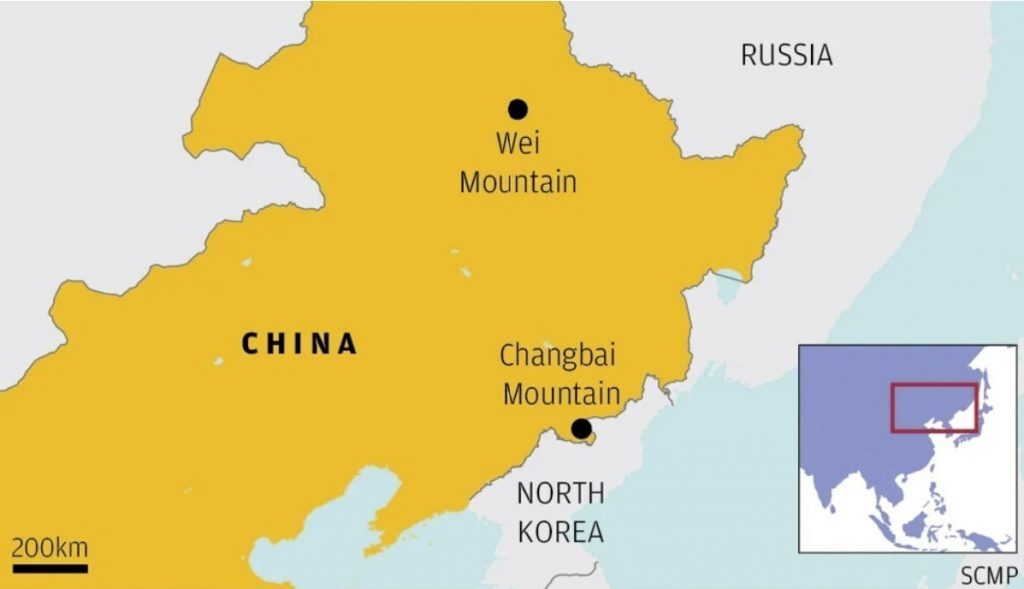
© HandoutWei Mountain is part of the Wudalianchi volcanic field in Heilongjiang province.
A volcano in northeast China could be "recharging" for an eruption, with a vast amount of magma believed to be rising up underneath it, according to a team of geophysicists.
The researchers say they discovered two huge magma chambers under Wei Mountain in the Wudalianchi volcanic field in Heilongjiang, near the border with Russia and North Korea. Their modelling suggests the chambers dwarf the volcano, which is 100 metres (328 feet) tall and 5km (3.1 miles) wide.
It was a surprise discovery, since the volcano last erupted more than 500,000 years ago and was considered extinct. Geologists have been more focused on Changbai, or Paektu Mountain, to the south, whose eruption in 946AD was one of the most powerful volcanic events ever recorded, its fallout zone spanning from Japan to Greenland.
But the volcanic fields of Changbai and Wei "would be linked to some degree", according to the peer-reviewed study, published in the journal
Geology this month.
Geophysicist Zhang Haijiang and a team from the University of Science and Technology of China in Hefei, Anhui, visited nearly 100 sites across Wei Mountain for the study.
They used sensors to detect electromagnetic abnormalities deep underground. They were looking for magma - which usually has a lower conductivity than hard rock - and they found it: an unusual blip from 15km underground, followed by another one at 8km.
Their computer modelling suggested there could be two giant magma chambers with a combined depth of more than 9km. Those chambers were part of a bigger system that could be "linked with the Changbai volcano by secondary mantle convection", Zhang wrote, referring to the process that causes tectonic plates to shift.
According to their calculations, 15 per cent of the upper chamber was now filled with molten rock. Some studies have suggested that a volcanic eruption could take place when a chamber fills to 40 per cent magma.Wei Mountain is part of the Wudalianchi volcanic field that has 14 cinder cones dotted over a 500 sq km plateau formed by lava. Previous studies have also found that Wudalianchi and Changbai could be connected.

© SCMPThe Weishan volcano and the Changbai volcano are related.
Zhang and the team noted that seismic activity had increased at Changbai from 2002 to 2005, suggesting "magmatic activity beneath the volcano was increased". Its most recent eruption was in 1903.
They concluded that "volcanic activity in northeast China is likely to be in an active stage, and active volcanic monitoring is needed to further understand the magmatic systems in this region".
Xu Jiandong, director of the volcanic research division at the China Earthquake Administration in Beijing, said the last eruption at the Wudalianchi field was in the early 18th century, forming two volcanic mountains - Laohei and Huoshao.
He said seismic stations had been monitoring the two young volcanoes for several decades.
"We have not detected any sign of active magma chambers under Laohei and Huoshao, which is very strange considering the recent eruption event," said Xu, who was not involved in the study.
The findings of the Wei Mountain study added to that mystery.
"If there really are huge magma chambers in the area, we should have detected some related seismic activities - when the lower chamber recharges the upper one, there should be some movement," he said. "But so far, after decades of monitoring on the site, we've picked up almost nothing. The whole area has been very, very quiet," he added.
That meant it was too early to say for sure that the chambers even existed, according to Xu.
He said while the abnormal signals detected by Zhang's team looked like magma chambers, they could also have been caused by other substances such as water or rocks with high conductivity.The study results would need to be verified by long-term seismic data that would be collected by new stations to be set up at Wei Mountain, Xu said.
"What we know for certain is that the Wudalianchi region is active - it's like congee boiling in a pot," he said.
Numerous studies in recent years have suggested a low risk of an immediate eruption in the area. For that reason, the government had not set up monitoring stations there, said Xu, adding that "we are not prepared for an eruption".
Reader Comments
to our Newsletter